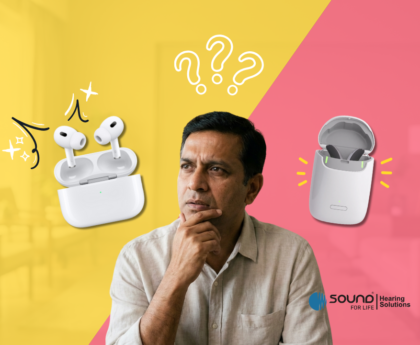Watching TV should be fun for everyone, but hearing loss can make it challenging. Many people, young or old, struggle to understand dialogue. It’s not just about volume; clarity matters. As one audiologist says, “it’s not just volume; it’s clarity”. Simply turning up the TV louder often “adds another layer of commotion” without helping. The good news is there are many friendly tricks and tools to fix this. You can enjoy your favorite shows again with a few adjustments and with the help of the right devices.
Simple things to try first
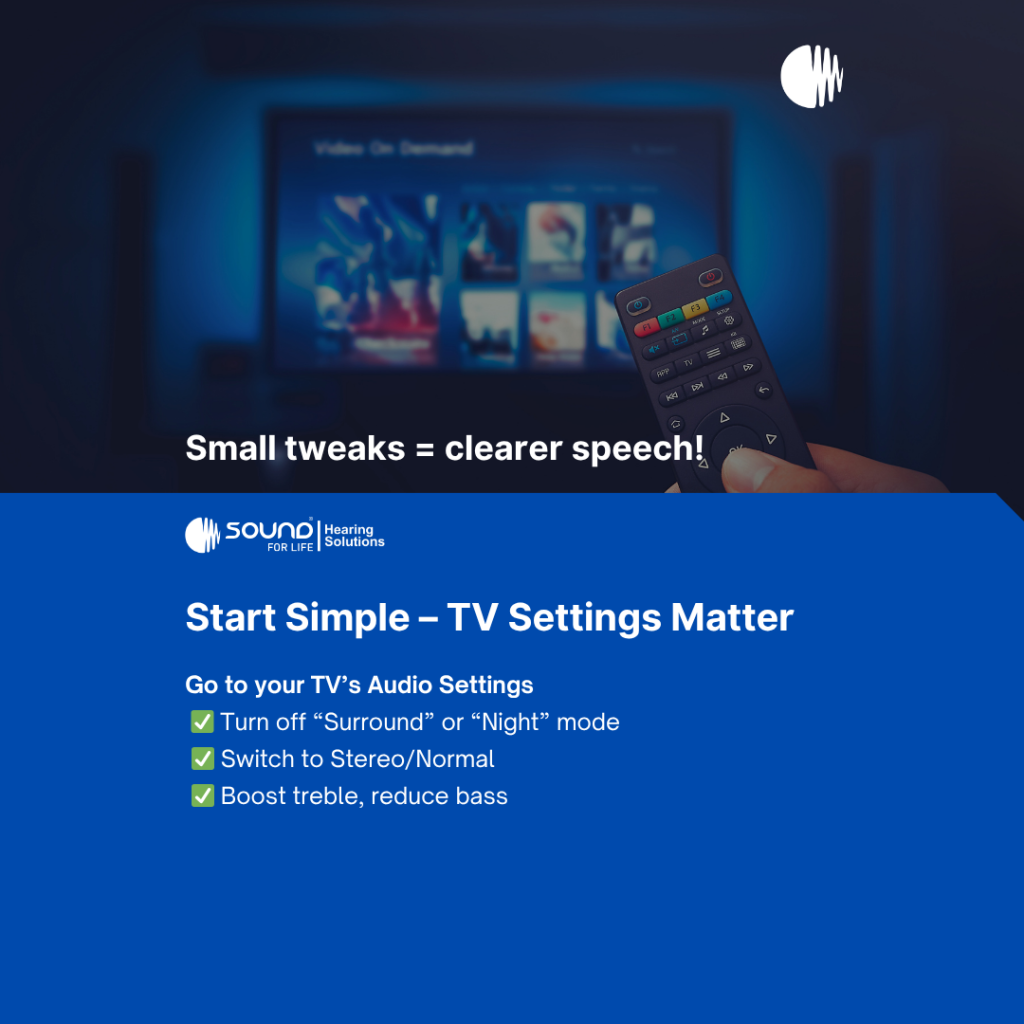
Check your TV settings
Most TVs have an Audio or Sound menu. Try turning off any “Night” or “Surround” modes and switch the audio to Stereo/Normal. For surround-sound systems, boost the center channel (that’s usually where dialogue comes from) and lower the other channels. If your TV has an equalizer, raise the higher frequencies (treble) and lower the bass – voices live in the high range, and boosting treble makes speech clearer.
Adjust the room
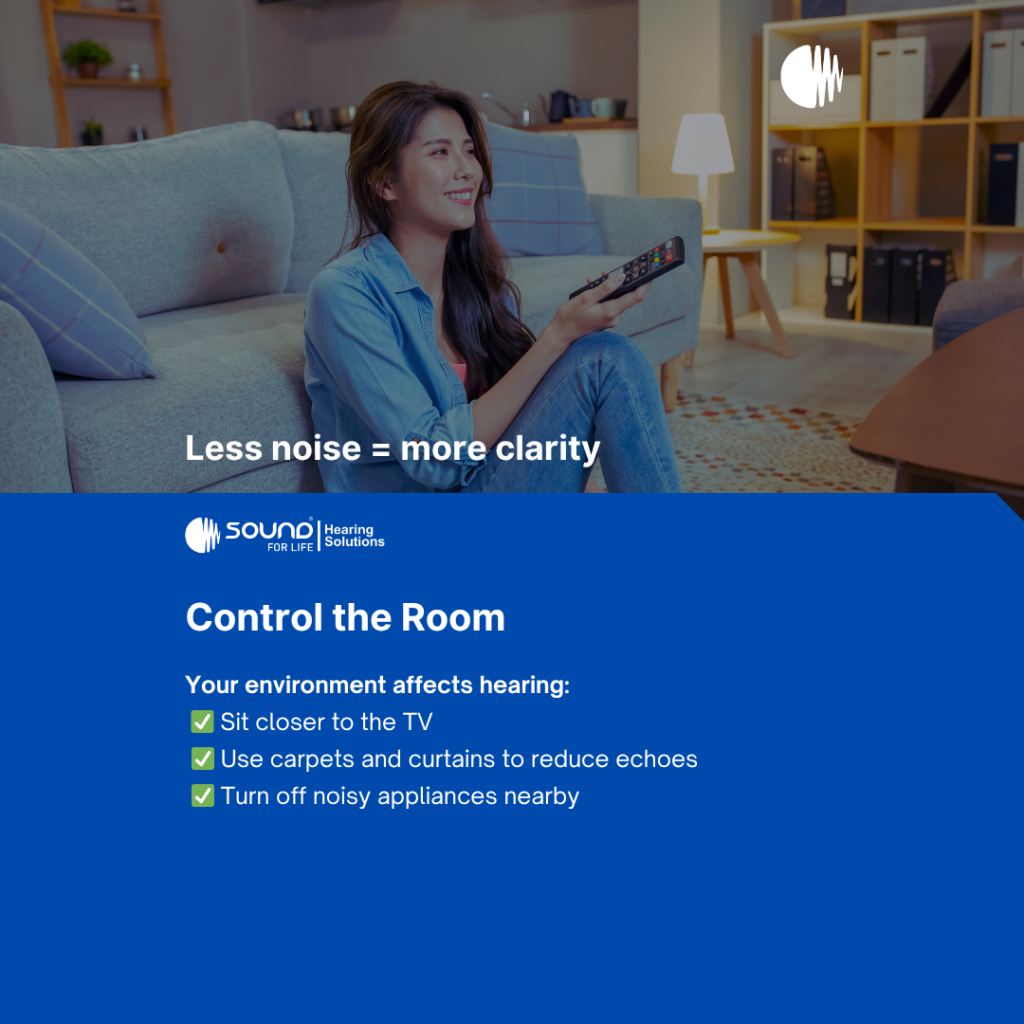
Sit as close as comfortable and face the TV. Choose a quiet room and add soft surfaces (carpets, curtains, pillows) to reduce echoes. Avoid rooms with hard floors or high ceilings. A smaller, calmer space helps you hear better.
Use the right speakers
If your TV has a built-in speech enhancement or dialogue mode, turn it on. Some TVs or sound systems have a “dialogue” or “voice” button, try it out to make voices pop. Also, make sure the TV is on the correct input (Stereo/Normal) rather than a complicated surround or night mode. Even a small change like this can make a big difference in clarity.
Control background noise
A peaceful environment lets your ears focus on the TV. Turn off or move away from noisy appliances like fans, air conditioners or radios. Mute your phone or ask family members to speak quietly. A peaceful environment lets your ears focus on the TV.
Trying these simple steps can often help you catch more words without making the volume painfully loud.
Using closed captions
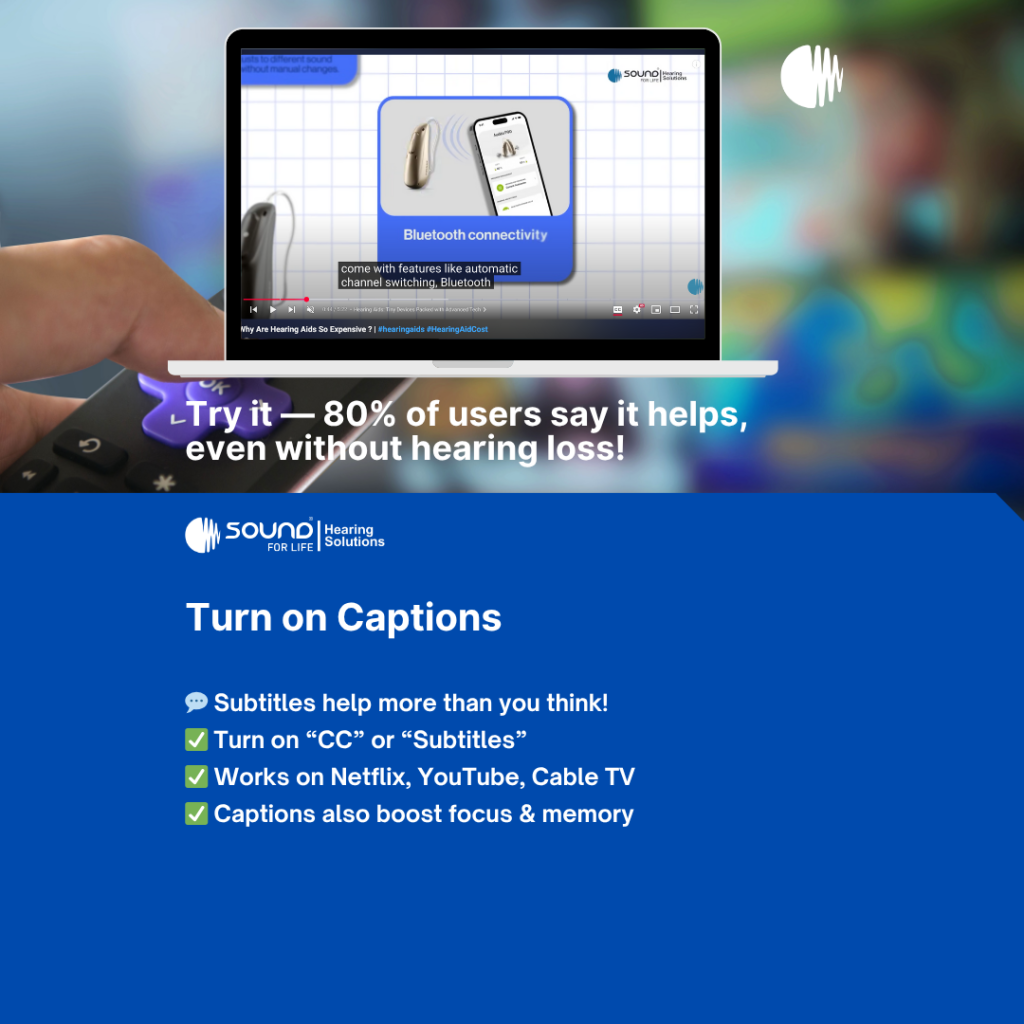
Closed captions (subtitles) can be a game-changer. Captions display all spoken words and even sounds like music or laughter on the screen. Captions “provide a text display of spoken words and sounds” to help people understand TV better. Turn on the CC or “Subtitles” button on your remote (it’s often labeled “CC”). You can read along with the dialogue, which makes following shows much easier.
Most TVs and streaming services have captions built in. For example, Netflix, Disney+, and YouTube all have subtitle options. Even network TV and cable offers CC (by FCC rule, all digital TVs must support it). Captions are usually very accurate for recorded shows. They work best on pre‑recorded programs, live news or sports captions can lag or be imperfect, but recorded shows and movies are usually spot on.
It can feel odd at first to watch TV with words at the bottom of the screen, but many people (even without hearing loss) use captions when rooms are noisy. In one survey, 80% of caption users had no hearing loss, they just wanted clarity. Give it a try: you might be surprised how much you start to enjoy it.
Hearing aids that work with TV
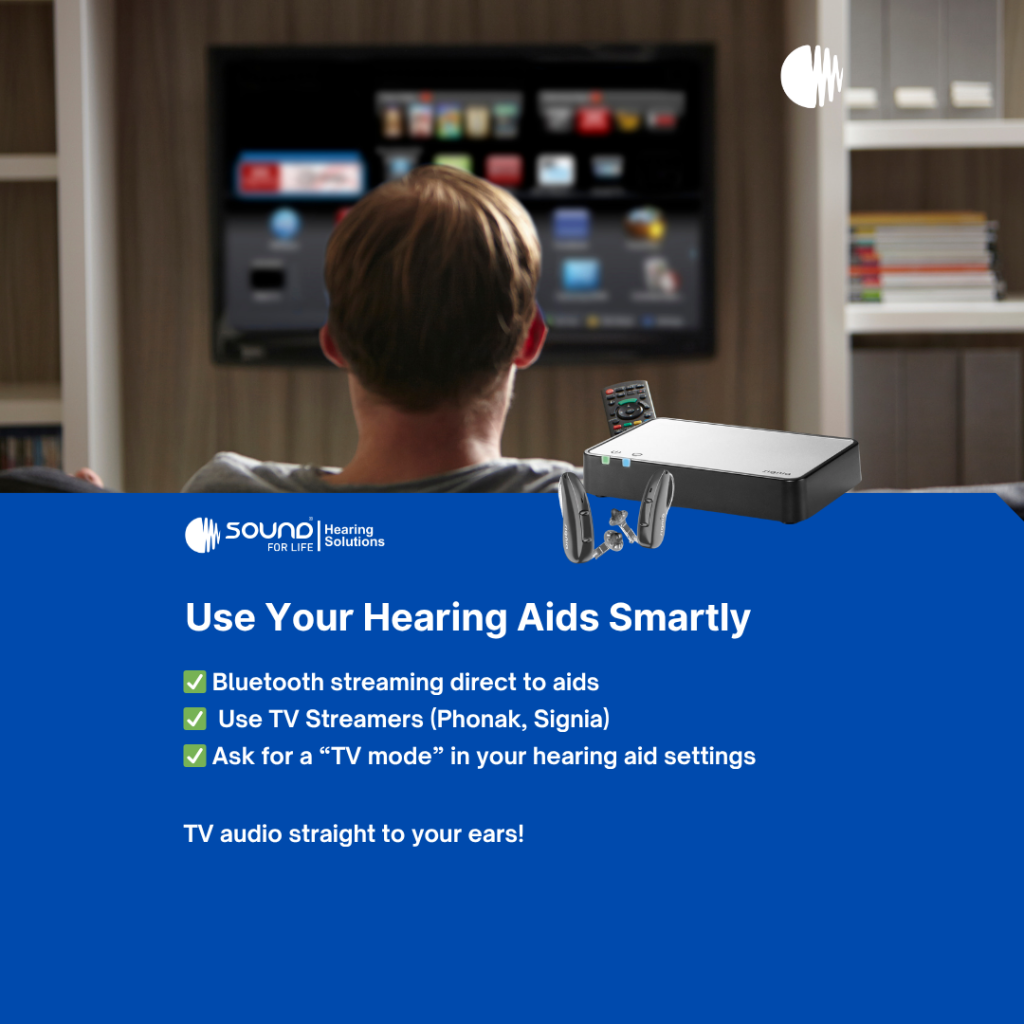
An example of a behind-the-ear hearing aid device
Modern hearing aids can make TV watching much easier. Many today have special features or accessories for streaming TV sound. For example, if your hearing aids have Bluetooth, you can pair them with a TV streamer or adapter so the sound goes straight into your ears. It’s like your hearing aids are wireless headphones! Some manufacturers (like Phonak or Oticon) even sell little TV streamers that plug into the TV and beam audio to your aids.
If your hearing aids have a telecoil (T-coil)
A telecoil can pick up sound from a magnetic hearing loop. You can install a room loop system (a wire around the room) that sends TV audio to your hearing aids. You simply switch your aids to the T-coil program and suddenly you hear the TV directly, with no room noise. Many theaters and auditoriums use this same loop system for the hearing impaired.
Even without these tech features, wearing your hearing aids and looking at the TV can help a lot. An audiologist notes that hearing aids reduce background noise and amplify voices in front of you. Ask your hearing professional to set up a “TV mode” in your aids they can tweak the settings so speech is easier to understand.
The bottom line: with the right setup, your hearing aids can connect you to your TV better than ever.
TV streamers and wireless listening systems
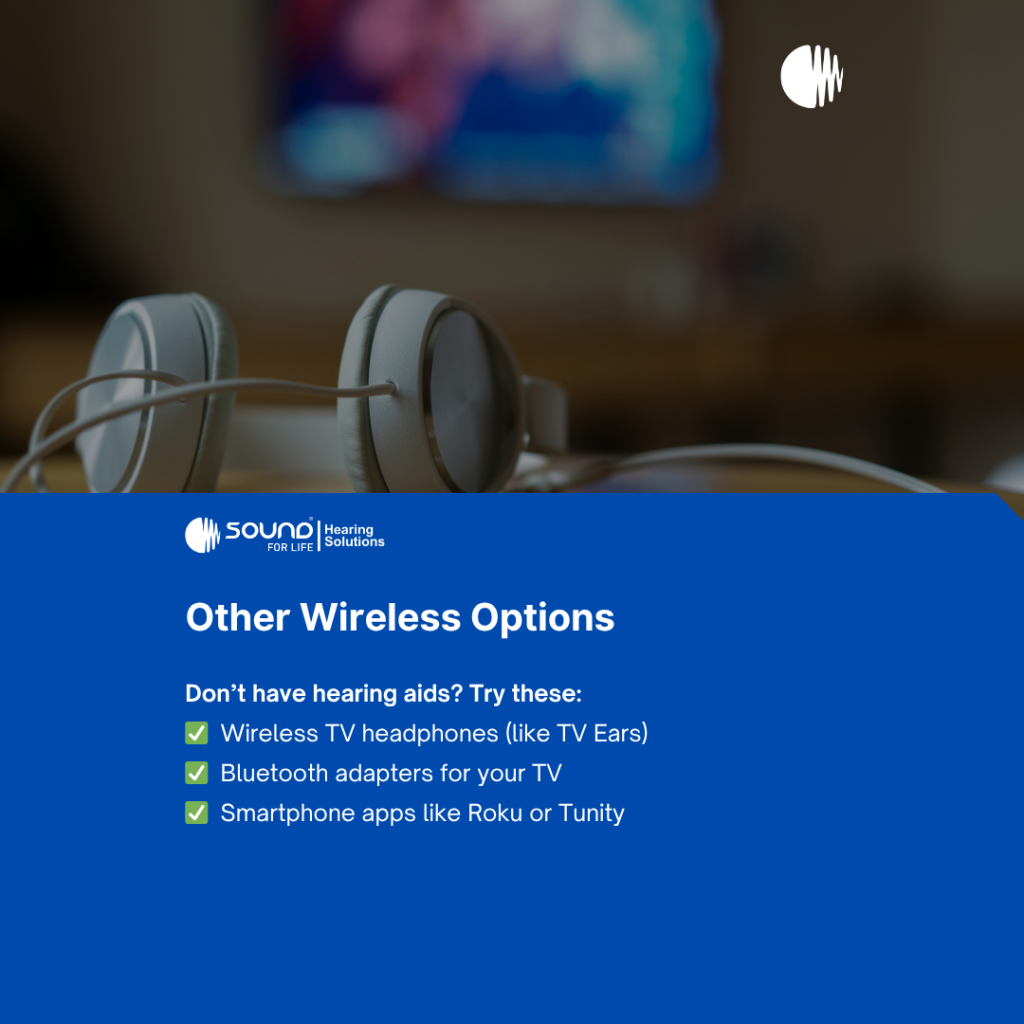
A pair of over-ear headphones for private listening
If hearing aids aren’t enough or you don’t use them, there are other wireless tricks. A Bluetooth or wireless transmitter can plug into your TV’s audio output. It sends the sound to wireless headphones or earbuds that you wear. Many people use TV-specific headphone systems like TV Ears. These systems have a base station that plugs into the TV and a headset (IR or RF) that you wear. You can crank up the volume in your ears without waking up the house! Captel’s experts note wireless headphones are great for boosting TV sound privately.
Streaming devices and apps
For example, the Roku app on your smartphone has a “private listening” feature. When you watch TV through Roku, the audio plays on your phone so you can listen with earbuds at your volume. Similarly, some TVs (like Amazon Fire TV) allow audio to stream to a mobile device. There’s even an app called Tunity: you point your phone camera at a muted live TV, and it recognizes the channel and streams the audio to your phone. You can then use your phone’s headphones or Bluetooth to hear the sound.
Induction loops and neckloops
These are another wireless option. A small personal loop (like a neck-worn loop) can pick up the TV sound (via a mic or jack) and send it magnetically to hearing aids. This is great when more than one person has hearing aids they can all tune in by switching to T-coil.
In short, you have many ways to bring the TV sound to your ears. Whether it’s a headset, a phone app, or a loop, the goal is to listen on your own terms.
● Wireless TV headphones: A base plugs into the TV, and you wear the headset. Famous examples include TV Ears or Sennheiser RS systems. Many are lightweight and have a built-in mic or special modes that make speech louder.
● Bluetooth adapters: If your TV or cable box lacks Bluetooth, you can buy a small transmitter (or use the audio-out jack) to send sound to any Bluetooth device even to your hearing aids.
● TV listening apps: Apps like Roku (private listening) or Tunity (live TV audio) let you stream TV sound to your phone. Then use earbuds or your hearing aid’s streaming feature for clarity.
● Hearing loops: A loop around the room or a personal neckloop transmits TV audio to hearing aids with telecoils. This is often used in public places, but you can set it up
at home too.
Special soundbars and speakers for hearing loss
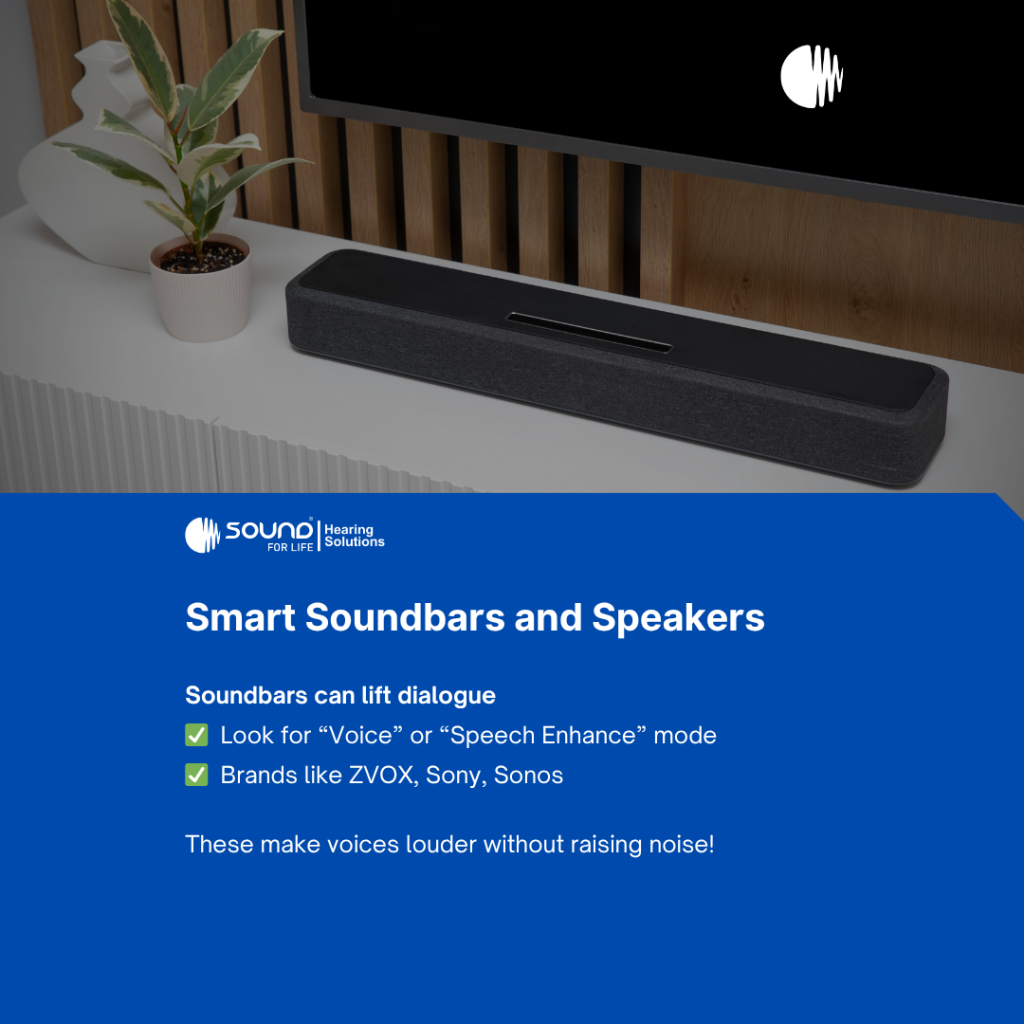
A soundbar or speaker system can greatly improve TV audio for everyone. Many modern soundbars emphasize clear dialogue. For example, ZVOX makes “AccuVoice” soundbars that literally apply hearing‑aid technology to TV sound: they isolate and lift out speech frequencies so voices stand out. Consumer Reports noted soundbars like the Sonos Playbar or Sony HT-ST7 even have “Speech Enhancement” or a “voice” mode to boost dialogue.
Using a good soundbar can make voices sound richer and fuller. Even a regular soundbar (without special branding) usually has settings for Night Mode or Voice Mode – try those and see if they help. Place the soundbar under your TV or on a shelf, and point it towards where you sit.
If you prefer small devices, personal sound amplifiers (PSAPs) are an option. These are over‑the‑ear or neck-worn amplifiers (like big earbuds or headphone amps) with their own volume knob. They act like wearable TV speakers: put them on, and they make the TV sound louder for you. They can be an affordable first try.
● Dialogue-boosting soundbars: Look for soundbars with a “voice” or “dialogue” setting. Some even have preset modes for people with hearing issues.
● Home theater speakers: A full sound system can help – just make sure to test the settings. Turn off extra surround effects and concentrate on a clear center channel (voices).
● Headphone amplifiers: You can also find desktop or floor-standing amplifiers (with big knobs) to plug headphones into for TV listening.
● PSAPs or TV amplifiers: Devices marketed as TV listening sets or personal amplifiers let you wear a small unit with earbuds or headphones to boost the sound.
Apps and smart TV features
Smart devices can lend a hand. Many streaming platforms and smart TVs have accessibility features: look for “Audio Description” (not just for vision – it often slows down narration) or “dialogue enhancement”. Check the Accessibility or Settings menu on your TV for any hearing-friendly options like volume leveling or sound presets.
Smartphone apps are useful too. As mentioned, Tunity can stream live TV audio to your phone. Also, the Roku and Amazon Fire apps can route TV audio to your phone (private listening). On your phone itself, built-in features help: both iPhone and Android have live caption/transcription modes. For example, Android’s Live Caption or iOS Live Listen can capture on‑screen speech and show it as text. These won’t replace big TV captions, but as a backup they can be handy (for example, watching a video on your tablet while also seeing text).
Finally, if you have hearing aids with companion apps (like myPhonak, ReSound Smart, etc.), use them. They often let you control volume and tone straight from the phone when streaming audio. The key is to explore the Accessibility or Hearing options on all your devices – there are often surprising tools built in.
Tips for parents with children who have hearing loss
Watching
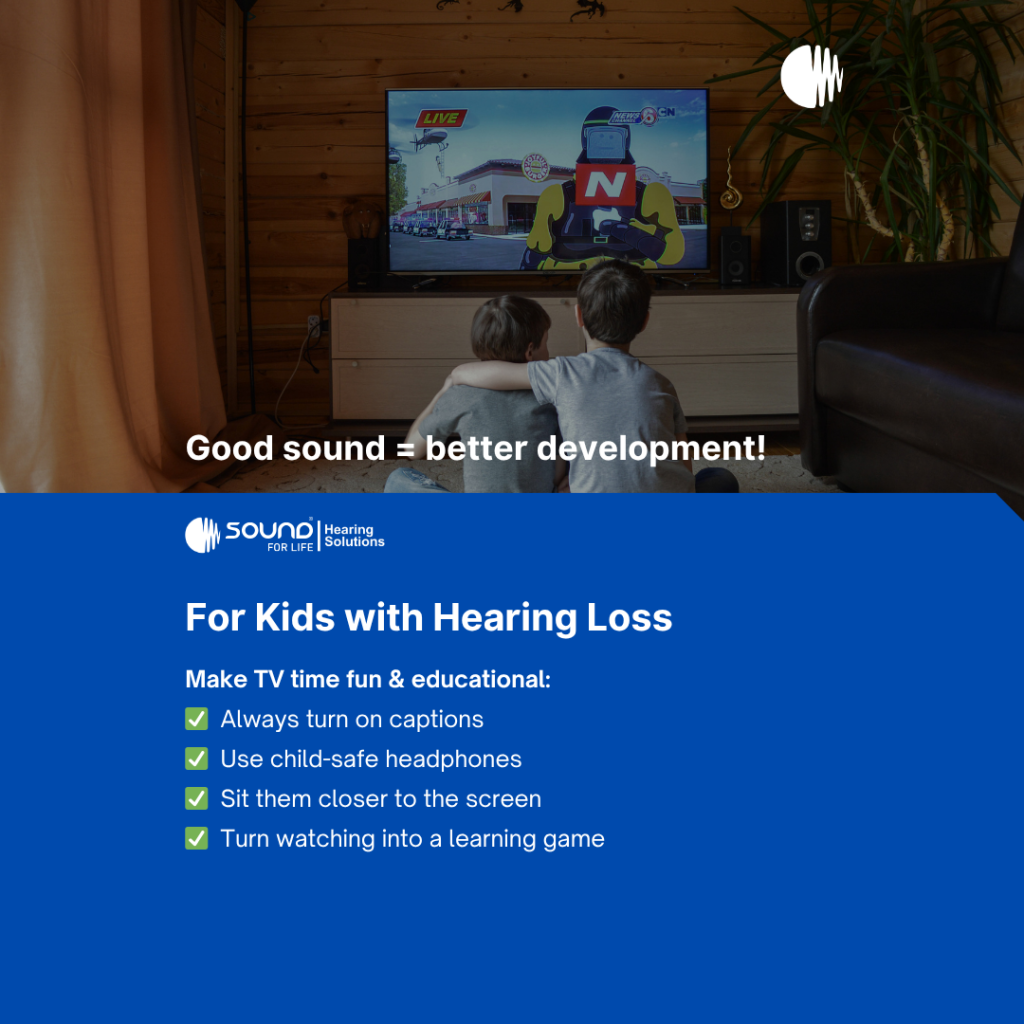
Watching TV can also be hard for kids with hearing loss, but these tips can help turn TV time into a positive learning experience:
● Use captions from day one: It’s never too early to turn on subtitles. Experts advise making captions the default when a child first watches TV. Even infants will start to associate symbols with sounds. Captions not only let kids follow the story, but they also boost reading and vocabulary skills. Over time, kids learn speech patterns and new words just by watching captioned programs.
● Get them good headphones: Children’s TV headphones (often with volume limits) let a child listen at a louder setting than the room provides. For example, systems like TV Ears can be paired with a child’s hearing aids or used with ear cups. Captel notes that wireless TV headsets allow private listening – kids can even move around and still hear clearly. This prevents fights over the remote and keeps the TV at a safe level for others.
● Keep their devices working: If your child uses hearing aids or cochlear implants, always check the batteries and connections before TV time. Develop a routine (like a nightly charging schedule) so their devices are ready. Having properly adjusted audiological equipment means they get the best sound.
● Control the environment: Sit your child close to the TV so they can also use visual cues (and read subtitles). Turn off other electronics and the TV sound while commercials or lower-interest parts play, so your child focuses when the main dialogue is on.
● Turn watching into learning: Ask your child questions about the show. Repeat lines together or spell new words from the captions. Watching shows multiple times (especially favorites) is great practice: repetition helps them catch what they missed the first time.
● Work with teachers and doctors: Mention the TV strategies at school too. Many schools have captioned media or loop systems. And be open with audiologists or speech therapists – they can offer more tailored tips for your child’s age and hearing level.
Remember, with patience and the right setup, TV can be both fun and educational for kids with hearing loss.
Encouragement
If you have hearing loss, watching TV might be difficult, but now you have so many tools at your disposal. If one attempt doesn’t work, don’t be discouraged, have patience and try something else! Continue adjusting settings, devices, and routines until you get the ideal balance. Treat yourself and your loved ones with patience. Reach out to hearing professionals or support groups if you need advice. Above all, keep in mind that you may once again enjoy television. You may enjoy your favourite shows with the same joy that millions of individuals with hearing loss do. With a little help and the right approach, TV time will be clear, comfortable, and enjoyable once again.





